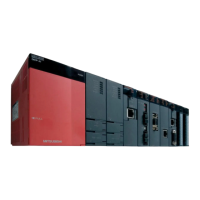10 - 17
10.2 Programming Using Bus Interface Functions
10.2.5 Restrictions on functions
10
FUNCTIONS AND PROGRAMMING
10.2.5 Restrictions on functions
There are the following restrictions on the bus interface functions and MELSEC data link
functions.
(1) Endian format (Memory layout)
The C Controller module has the endian format (memory layout) of little endian.
Create the user program in the little endian system.
(The complier setting becomes little endian by selecting "SH7750gnule" in "A
toolchain" when creating a project on Tornado.)
( Section 10.2.3)
(2) Execution type priority
Set the priority of the task that executes the user program as described below.
(a) When access is not made via FTP during user program execution
Set the priority of the user program task to 100 or more (100 to 255).
If the priority is set to 0 to 99, the system may not operate properly.
(b) When access is made via FTP during user program execution
The actual FTP processing (task) of the C Controller module is performed at the
priority of 200.
When making access via FTP during user program execution, perform
programming as described below.
1) Set the priority of the user program task to 201 to 255.
2) When setting the priority of the user program task to 100 to 200, insert wait
processing (such as taskDelay) in the user program to make the actual FTP
processing enabled.
(3) User program execution
Execute the user program by starting the task from the script file.
( Section 10.2.8)
The system may malfunction if the user program is executed without the task being
started.
(4) When Ethernet communication is made from user program
The port numbers 20756, 21012, and 21268 are not applicable.
(5) When file is written from user program
Do not write the file to the standard ROM.
Write it to a CompactFlash card or a network device (FTP/ NFS/netDrv driver, etc.)
file.
For details of network devices, refer to the VxWorks manual.
(6) CompactFlash card replacement
Refer to Section 5.8 when replacing the CompactFlash card with power on.

